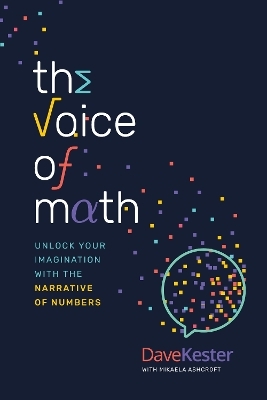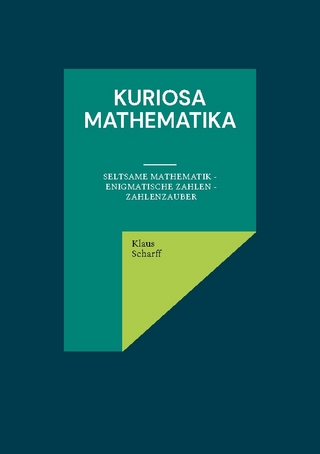
A Course in Computational Number Theory
John Wiley & Sons Inc (Verlag)
978-0-470-41215-2 (ISBN)
David Bressoud is DeWitt Wallace Professor of Mathematics at Macalester College and president-elect of the Mathematical Association of America. He served in the Peace Corps, teaching math and science at the Clare Hall School in Antigua, West Indies before studying with Emil Grosswald at Temple University and then teaching at Penn State for 17 years, eight of them as full professor. He chaired the Department of Mathematics and Computer Science at Macalester from 1995 until 2001. He has held visiting positions at the Institute for Advanced Study, the University of Wisconsin-Madison, the University of Minnesota, Université Louis Pasteur (Strasbourg, France), and the State College Area High School. David has received the MAA Distinguished Teaching Award (Allegheny Mountain Section), the MAA Beckenbach Book Award for Proofs and Confirmations, and has been a Pólya Lecturer for the MAA. He is a recipient of Macalester's Jefferson Award. He has published over fifty research articles in number theory, combinatorics, and special functions. His other books include Factorization and Primality Testing, Second Year Calculus from Celestial Mechanics to Special Relativity, A Radical Approach to Real Analysis (now in 2nd edition), and, with Stan Wagon, A Course in Computational Number Theory. His latest book, A Radical Approach to Lebesgue's Theory of Integration, is due out by the end of 2007. David chairs the MAA special interest group, Teaching Advanced High School Mathematics. He has chaired the AP Calculus Development Committee and has served as Director of the FIPSE-sponsored program Quantitative Methods for Public Policy. He has been involved in the activities and programs of both the Mathematical Association of America and the American Mathematical Society.
Preface. Notation.
Chapter 1 Fundamentals.
1.0 Introduction.
1.1 A Famous Sequence of Numbers.
1.2 The Euclidean ALgorithm.
The Oldest Algorithm.
Reversing the Euclidean Algorithm.
The Extended GCD Algorithm.
The Fundamental Theorem of Arithmetic.
Two Applications.
1.3 Modular Arithmetic.
1.4 Fast Powers.
A Fast Alforithm for ExponentiationPowers of Matrices, Big-O Notation.
Chapter 2 Congruences, Equations, and Powers.
2.0 Introduction.
2.1 Solving Linear Congruences.
Linear Diophantine Equations in Two Variables.
The Conductor.
An Importatnt Quadratic Congruence.
2.2 The Chinese Remainder Theorem.
2.3 PowerMod Patterns.
Fermat's Little Theorem.
More Patterns in Powers.
2.4 Pseudoprimes.
Using the Pseudoprime Test.
Chapter 3 Euler's Function.
3.0 Introduction.
3.1 Euler's Function.
3.2 Perfect Numbers and Their Relatives.
The Sum of Divisors Function.
Perfect Numbers.
Amicalbe, Abundant, and Deficient Numbers.
3.3 Euler's Theorem.
3.4 Primitive Roots for Primes.
The order of an Integer.
Primes Have PRimitive roots.
Repeating Decimals.
3.5 Primitive Roots for COmposites.
3.6 The Universal Exponent.
Universal Exponents.
Power Towers.
The Form of Carmichael Numbers.
Chapter 4 Prime Numbers.
4.0 Introduction.
4.1 The Number of Primes.
We'll Never Run Out of Primes.
The Sieve of Eratosthenes.
Chebyshev's Theorem and Bertrand's Postulate.
4.2 Prime Testing and Certification.
Strong Pseudoprimes.
Industrial-Grade Primes.
Prime Certification Via Primitive Roots.
An Improvement.
Pratt Certificates.
4.3 Refinements and Other Directions.
Other PRimality Tests.
Strong Liars are Scarce.
Finding the nth Prime.
4.4 A Doszen Prime Mysteries.
Chapter 5 Some Applications.
5.0 Introduction.
5.1 Coding Secrets.
Tossing a Coin into a Well.
The RSA Cryptosystem.
Digital Signatures.
5.2 The Yao Millionaire Problem.
5.3 Check Digits.
Basic Check Digit Schemes.
A Perfect Check Digit Method.
Beyond Perfection: Correcting Errors.
5.4 Factoring Algorithms.
Trial Division.
Fermat's Algorithm.
Pollard Rho.
Pollard p-1.
The Current Scene.
Chapter 6 Quadratic Residues.
6.0 Introduction.
6.1 Pepin's Test.
Quadratic Residues.
Pepin's Test.
Primes Congruent to 1 (Mod.
6.2 Proof of Quadratic Reciprocity.
Gauss's Lemma.
Proof of Quadratic Recipocity.
Jacobi's Extension.
An Application to Factoring.
6.3 Quadratic Equations.
Chapter 7 Continuec Faction.
7.0 Introduction.
7.1 FInite COntinued Fractions.
7.2 Infinite Continued Fractions.
7.3 Periodic Continued Fractions.
7.4 Pell's Equation.
7.5 Archimedes and the Sun God's Cattle.
Wurm's Version: Using Rectangular Bulls.
The Real Cattle Problem.
7.6 Factoring via Continued Fractions.
Chapter 8 Prime Testing with Lucas Sequences.
8.0 Introduction.
8.1 Divisibility Properties of Lucas Sequencese.
8.2 Prime Tests Using Lucas Sequencesse.
Lucas Certification.
The Lucas-Lehmer Algorithm Explained.
Luca Pseudoprimes.
Strong Quadratic Pseudoprimes.
Primality Testing's Holy Grail.
Chapter 9 Prime Imaginaries and Imaginary Primes.
9.0 Introduction.
9.1 Sums of Two Squares.
9.2 The Gaussian Intergers.
Complex Number Theory.
Gaussian Primes.
The Moat Problem.
The Gaussian Zoo.
9.3 Higher Reciprocity 325.
Appendix A. Maathematica Basics.
1.0 Introduction.
A.1 Plotting.
A.2 Typesetting.
Sending Files By E-Mail.
A.3 Types of Functions.
A.4 Lists.
A.5 Programs.
A.6 Solving Equations.
A.7 Symbolic Algebra.
Appendix B Lucas Certificates Exist.
References.
Index of Mathematica Objects.
Subject Index.
| Erscheint lt. Verlag | 6.11.2008 |
|---|---|
| Verlagsort | New York |
| Sprache | englisch |
| Maße | 185 x 239 mm |
| Gewicht | 874 g |
| Themenwelt | Mathematik / Informatik ► Mathematik ► Arithmetik / Zahlentheorie |
| ISBN-10 | 0-470-41215-1 / 0470412151 |
| ISBN-13 | 978-0-470-41215-2 / 9780470412152 |
| Zustand | Neuware |
| Haben Sie eine Frage zum Produkt? |
aus dem Bereich


